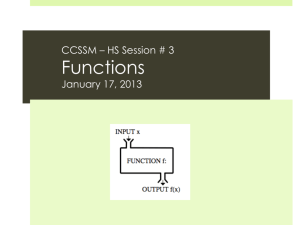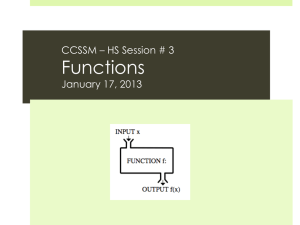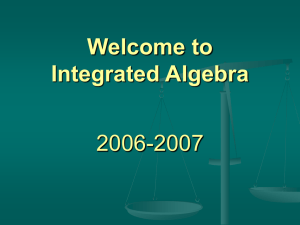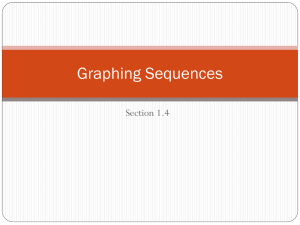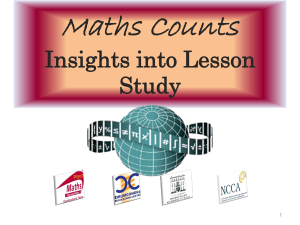Functions-Powerpoint..
advertisement
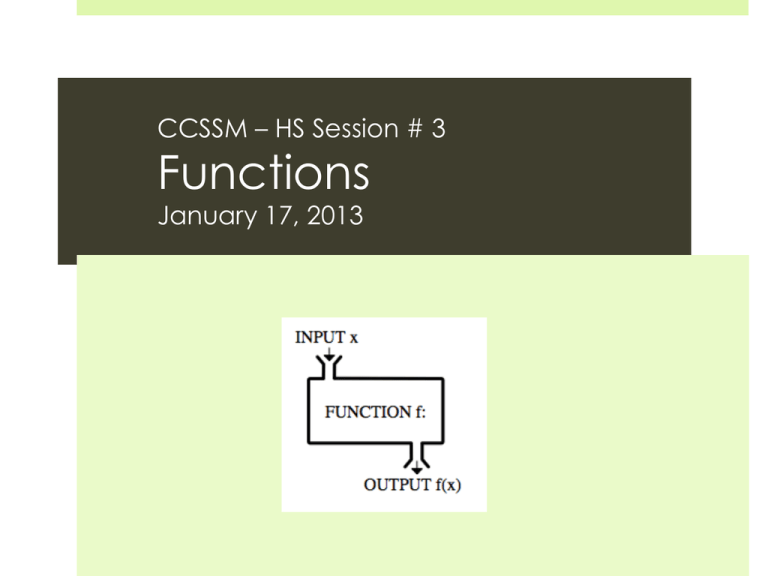
CCSSM – HS Session # 3 Functions January 17, 2013 Functions are Fundamental “Functions are truly fundamental to mathematics. In everyday language we say, “The price of a ticket is a function of where you sit,” or “The fuel needed to launch a rocket is a function of its payload.” In each case, the word function expresses the idea that knowledge of one fact tells us another. In mathematics, the most important functions are those in which knowledge of one number tells us another. If we know the length of the side of a square, its area is determined. If the circumference of a circle is known, its radius is determined.” From Calculus: Single Variable, Second Edition, Hughes-Hallett, Gleason, et al. A Function is a Tool “A mathematician needs functions for the same reason that a builder needs hammers and drills. Tools transform things. So do functions. In fact, mathematicians often refer to them as transformations because of this. But instead of wood and steel, the materials that functions pound away on are numbers and shapes, and, sometimes, even other functions.” Stephen Strogatz, The Joy of X Formal Definitions of Functions Function Definition Activity In small groups, sort definitions Discuss with your group: What characteristics do the definitions have in common? To what aspects of the function do all of the definitions draw students’ and teachers’ attention? This activity and other content in this Powerpoint presentation is from the book Developing Essential Understanding of Functions (9 – 12), NCTM (2010) The Rule of Four “Where appropriate, topics should be presented Geometrically Numerically Analytically Verbally From Calculus: Single Variable, Second Edition, HughesHallett, Gleason, et al. Outline for Functions Presentation Grade 8 Function Introduction HS Algebra I Function Topics Modeling Tasks Covariation and Rates of Change Sequences as Functions Growing Patterns as Functions Families of Functions Sample Tasks HS CCSSM Functions Presentation HS Algebra II Function Topics Polynomial Functions Rational Functions Radical Functions Exponential Functions Logarithmic Functions as Solutions for Exponentials Trigonometric Functions Sample Tasks Function Introduction in Grade 8 The Grade 8 CCSSM expects that students: Understand that a function is a rule that assigns to each input exactly one output Understand that the graph of a function is a set of ordered pairs consisting of an input and its corresponding output Are able to comfortable move between the different representations in the Rule of Four Interpret y = mx+b as the equation of a linear function Be able to give examples of functions that are not linear Function Introduction in Grade 8 The Grade 8 CCSSM expects that students can Construct a function to model a linear relationship. Determine the rate of change and initial value, given: A description of a the relationship Two (x,y) values (from a table or from a graph) Interpret the rate of change and the initial value In terms of the situation it models In terms of its graph or table of values Function Introduction in Grade 8 The Grade 8 CCSSM expects that students can Describe qualitatively the functional relationship between two quantities by Analyzing a graph: increasing, decreasing, linear, non-linear Sketch a graph that Exhibits given qualitative features of a function or has been described verbally Interpreting Functions in Algebra I Understand the concept of a function and use function notation Focus on Linear functions Exponential functions Arithmetic sequences Geometric sequences (F.IF.1, 2, 3) Read these standards Interpreting Functions in Algebra I Graph functions expressed symbolically and show key features by hand in simple cases, or by graphing technology Analyze Linear functions (show intercepts) Exponential functions (show intercepts and end behavior) Quadratic functions (show intercepts and maxima/minima) Absolute value functions (show intercepts) Step functions Piecewise-defined functions Building Functions in Algebra I Build a function that models a relationship between two quantities (Read F.BF.1, 2) Linear Exponential Quadratic Build new functions from existing functions (Read F.BF.3,4a) Linear only for F.BF.4a Quadratic Absolute Value Models in Algebra I Construct and compare linear, quadratic, and exponential models and solve problems Read F.LE.1a, 1b, 1c, 2, 3 Interpret expressions for functions in terms of the situation they model Linear Exponential of form f(x) = bx + k Read F.LE.5 Circular Animal Pen Think about all possible circular animal pens enclosed by a length of fencing. For each length of fencing, there is the corresponding area that the fencing will enclose when it is formed into a circle. Describe the relationship between the area of a circular animal pen and the length of the fencing that it takes to enclose the pen. From Developing Essential Understanding of Functions, NCTM (2010) Circular Animal Pen When we use an equation such as A = L2/(2π)to describe the relationship, we are implying the the “mapping” definition. Each value of L maps to a value of A by following the rule set forth in the equation. When we sketch of graph of the function, we view the functions as consisting of ordered pairs of the form [L, L2/(2π)]. When we create a table, we bridge the mapping and ordered pair definitions. Each entry in the input column maps to the corresponding entry in the output column AND the two entries in each row form an ordered pair. Covariation and Rate of Change Using a covariation approach is an important first step in developing a fuller comprehension of the function concept. The rate of change of a function describes the covariation between two variables (input and output). In other words, how one variable quantity changes with respect to the other variable. A function’s rate of change is one of the main characteristics that determine what kinds of real world phenomena the function can model. Rate of Change Tables are a good way to observe covariation From a covariation perspective (lens), a function is understood as a juxtaposition of two sequences, each of which is generated independently through a pattern of values. In the function at right, what stands out from a covariation perspective? x f(x) -1 1 0 1 1 3 2 7 3 13 4 21 Defining Rate of Change A rate of change is a rate! change in output value change in input value When students see only tables where the change in input value is 1, they may think that the rate of change is only the change in the output value! Defining Rate of Change Average and instantaneous rates of change Suppose that it starts to rain at noon. falls. Between 2 PM and 6 PM a total of 12 millimeters of rain What is the rate of change between noon and 6 PM? What is the rate of change between 2 PM and 6 PM? What is the rate of change between 3 PM and 4 PM? What is the rate of change at 5 PM? Looking at tables through different perspectives When you look at the table from a x y -2 4 -1 1 0 0 1 1 When you look at the table from a 2 4 correspondence or mapping perspective, 3 9 4 16 covariation perspective, what do you notice? what you do notice? Looking at Covariation Patterns for Clues as to Function Family Research indicates that students typically use a covariation perspective before attempting to generalize the relationships with a mapping perspective The pattern of covariation gives students a clue as to what function family the table describes x f(x) = 3x + 2 -1 -1 0 2 1 5 1 2 8 1 3 11 A linear function has a constant rate of change The ratio of the change in output to the 1 change in input is constant 1 3 3 3 3 Looking at Covariation Patterns for Clues as to Function Family A quadratic function has a linear rate of change As the input changes by one unit, the output changes at a constant rate This constant rate can be seen by finding the second differences x f(x) = 3x2 + 2 -1 5 0 2 1 5 1 2 14 1 3 29 1 1 Linear Constant -3 3 9 15 6 6 6 Rate of Change Exponential functions have a rate of change that is proportional to the value of the function. Whenever the input is increased by 1 unit*, the output is multiplied by a constant factor, x 2x which is the base. Rate of change = 2*f(x) *Note that this constant factor is not as readily seen when the input is increased by a value other than 1 unit. -1 2-1 = ½ 0 20 = ½ * 2 = 1 1 21 2 22 3 23 = 4*2 = 8 = 1*2 = 2 = 2*2 = 4 ½ 1 2 4 Sequences as Functions Sequences represent a special type of function whose domain is the counting numbers. Arithmetic sequences have a constant rate of change and are related to linear functions. Geometric sequences have a variable rate of change and are related to exponential functions. Growing patterns can have constant or variable rates of change and are generally related to polynomial functions. Sequences as Functions Arithmetic Sequences A sequence is arithmetic if each term beyond the first term can be obtained from the previous term by adding a constant m (m can be positive, negative, or zero). 5, 9, 13, 17, 21… 1.6, 1.1, 0.6, 0.1, -0.4, -0.9, -1.4… Recursive Rule: NEXT = NOW + m Sequences as Functions Arithmetic Sequences 5, 9, 13, 17, 21… 1.6, 1.1, 0.6, 0.1, -0.4, -0.9, -1.4… The Recursive Rule is easy to define: NEXT = NOW + m What is the Recursive Rule of the above sequences? Sequences as Functions Arithmetic Sequences 1, 4, 7, 10, 13… and 1, 5, 9, 13, 17 The rule that assigns a sequence value to a specific counting, such as “what is the 100th term in the sequence” is harder to recognize. Find the formulas in terms of N for the Nth entries of the sequences. (Let N = 1 be the first entry in each series) Finding the formula generally requires identifying what the the “0th” entry in the sequence would be. What relationship do you see between the recursive rules (NEXT = NOW + m and the formulas (input the term # and output the sequence value)? Sequences as Functions Geometric Sequences Define the recursive rule for each sequence below Find the formula in terms of N for any term in each sequence 10, 20, 40, 80… and 5, 5/3, 5/9, 5/27… What relationship do you see between the recursive rules and the formulas? Growing Patterns as Functions See Handout: Seeing Structure and Developing Rules for Patterns See Fawn Nguyen’s Patterns Poster See Patterns Poster for Algebra I See Fawn Nguyen’s Visual Patterns Website Families of Functions Functions are often studied and understood as families, and students should spend time studying functions within a family, varying parameters to understand how the parameters affect the graph of the function and its key features. Families of Functions F-IF.7 indicates that the following functions should be in students’ repertoires: Linear and quadratic (show intercepts, maxima, and minima) Square root, cube root, piecewise (step functions and absolute value functions) Polynomial functions (identify zeros when suitable factorizations available and show end behavior Families of Functions F-IF.7 indicates that the following functions should be in students’ repertoires: Exponential and logarithmic functions Showing intercepts and end behavior Trigonometric functions Showing period, midline, and amplitude (+) Rational functions Identifying zeros and asymptotes when suitable factorizations available, showing end behavior F-IF.A.1 Task Suppose f is a function. If 10=f(−4), give the coordinates of a point on the graph of f. If 6 is a solution of the equation f(w)=1, give a point on the graph of f. Commentary: This task is designed to get at a common student confusion between the independent and dependent variables. This confusion often arises in situations like (b), where students are asked to solve an equation involving a function, and confuse that operation with evaluating the function. This task is adapted from Functions Modeling Change: A Preparation for Calculus, Connally et al., Wiley 2010. F-IF.A.1 Parking Lot A parking lot charges $0.50 for each half hour or fraction thereof, up to a daily maximum of $10.00. Let C(t) be the cost in dollars of parking for t minutes. t (minutes) Complete the table Sketch a graph of C for 0 ≤ t ≤480. Is C a function of t? Explain your reasoning. Is t a function of C? Explain your reasoning. 0 15 20 35 75 125 C(t) (dollars) F-IF.A.2 Let f(t) be the number of people, in millions, who own cell phones t years after 1990. Explain the meaning of the following statements. f(10)=100.3 f(a)=20 f(20)=b n=f(t) from Illustrative Mathematics Functions in Algebra II Interpret functions that arise in applications in terms of a context (Modeling) Extend modeling with functions introduced in Algebra I to include trigonometric functions and periodicity Analyze functions using different representations Focus on using key features to guide selection of appropriate type of model function Extend analysis with function introduced in Algebra I to include polynomial functions and logarithmic functions (Read F-IF.7c,d(+), e) Functions in Algebra II Analyze functions using different representations Write a function defined by an expression in different but equivalent forms to reveal and explain different properties of the function Factoring and completing the square (Read F-IF.8a) Using properties of exponents (Read F-IF.8b) Compare properties of two functions each represented in a different way (Read F-IF.9) Functions in Algebra II Building Functions Continue work started in Algebra I on Building Functions through adding, subtracting, multiplying, and dividing functions. Include simple radical, rational, and exponential functions Identify the effect of rigid transformations and non-rigid transformations on the domain and range of a function Emphasize common effect of each transformation across functions types Find inverse functions Functions in Algebra II Linear, Quadratic, and Exponential Models Continue work started in Algebra I on modeling with linear, quadratic, and exponential functions Introduce logarithms as solutions for exponents. Read F.LE.4 Functions in Algebra II Trigonometric Functions Extend the domain of trigonometric functions using the unit circle (Read F.TF.1,2) Model periodic phenomena with trigonometric functions (Read F.TF.5) Prove and apply trigonometric identities (Read F.TF.8) More Functions Tasks F-IF Pizza Place Promotion F-BF Crude Oil and Gas Mileage F-BF US Households F-LE Comparing Exponentials F-LE Newton's Law of Cooling F-TF Foxes and Rabbits 2 PARCC Example Get this from http://www.parcconline.org/s amples/mathematics/highschool-functions
